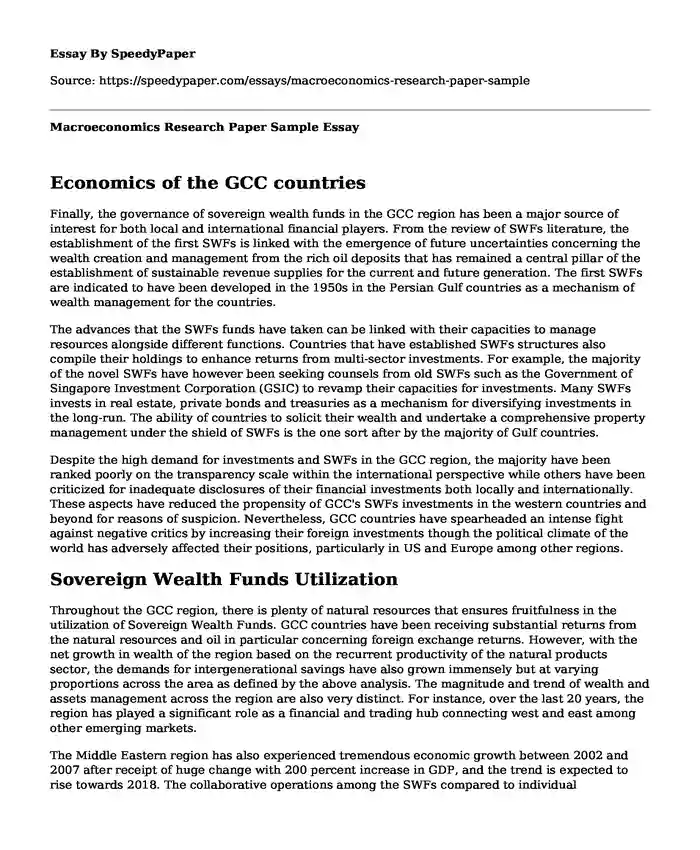
| Type of paper: | Research paper |
| Categories: | Economics Macroeconomics Geography |
| Pages: | 3 |
| Wordcount: | 624 words |
Economics of the GCC countries
Finally, the governance of sovereign wealth funds in the GCC region has been a major source of interest for both local and international financial players. From the review of SWFs literature, the establishment of the first SWFs is linked with the emergence of future uncertainties concerning the wealth creation and management from the rich oil deposits that has remained a central pillar of the establishment of sustainable revenue supplies for the current and future generation. The first SWFs are indicated to have been developed in the 1950s in the Persian Gulf countries as a mechanism of wealth management for the countries.
The advances that the SWFs funds have taken can be linked with their capacities to manage resources alongside different functions. Countries that have established SWFs structures also compile their holdings to enhance returns from multi-sector investments. For example, the majority of the novel SWFs have however been seeking counsels from old SWFs such as the Government of Singapore Investment Corporation (GSIC) to revamp their capacities for investments. Many SWFs invests in real estate, private bonds and treasuries as a mechanism for diversifying investments in the long-run. The ability of countries to solicit their wealth and undertake a comprehensive property management under the shield of SWFs is the one sort after by the majority of Gulf countries.
Despite the high demand for investments and SWFs in the GCC region, the majority have been ranked poorly on the transparency scale within the international perspective while others have been criticized for inadequate disclosures of their financial investments both locally and internationally. These aspects have reduced the propensity of GCC's SWFs investments in the western countries and beyond for reasons of suspicion. Nevertheless, GCC countries have spearheaded an intense fight against negative critics by increasing their foreign investments though the political climate of the world has adversely affected their positions, particularly in US and Europe among other regions.
Sovereign Wealth Funds Utilization
Throughout the GCC region, there is plenty of natural resources that ensures fruitfulness in the utilization of Sovereign Wealth Funds. GCC countries have been receiving substantial returns from the natural resources and oil in particular concerning foreign exchange returns. However, with the net growth in wealth of the region based on the recurrent productivity of the natural products sector, the demands for intergenerational savings have also grown immensely but at varying proportions across the area as defined by the above analysis. The magnitude and trend of wealth and assets management across the region are also very distinct. For instance, over the last 20 years, the region has played a significant role as a financial and trading hub connecting west and east among other emerging markets.
The Middle Eastern region has also experienced tremendous economic growth between 2002 and 2007 after receipt of huge change with 200 percent increase in GDP, and the trend is expected to rise towards 2018. The collaborative operations among the SWFs compared to individual investments could also end up in lobbying for engagements in other governmental matters facilitated by SWFs agencies in the region. In future, SWFs is anticipated to play a pivotal role in the world economy since many states relying mainly on the oil product have been working in pursuit of establishing and diversifying their investments both locally and internationally. Throughout the global perspective, many countries that have well-established SWFs have commenced these investment options to promote the development and progressive enhancement of their economies within local and international segments. Subsequently, as indicated by the analysis of this research, these funds have been established from the proceeds of oil and gas or other non-commodity products. These aspects have continuously fueled the growth of the regional economy besides reinstating the strength of the local economy.
Cite this page
Macroeconomics Research Paper Sample. (2018, Jan 25). Retrieved from https://speedypaper.net/essays/macroeconomics-research-paper-sample
Request Removal
If you are the original author of this essay and no longer wish to have it published on the SpeedyPaper website, please click below to request its removal:
- Research Paper Sample on the Use of Music in Teaching and Learning
- Medical Marijuana and the Mind, Essay Example for Everyone
- Essay Sample on Developing a Shared Vision in a Healthcare Institution
- Research Paper Example
- Critical Analysis Essay Example: Dynamic Self-Concept
- Essay Example: Harmony between National Security and Freedom
- Free Essay Example - the Entertainer
Popular categories




